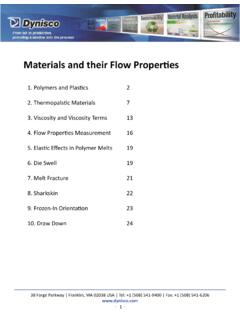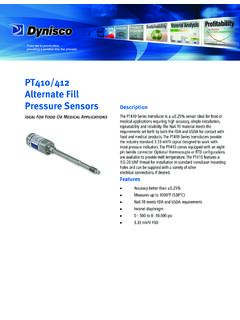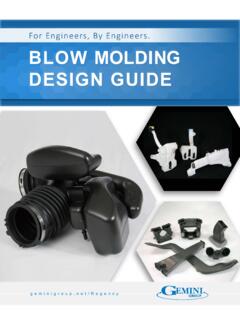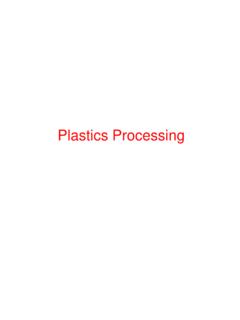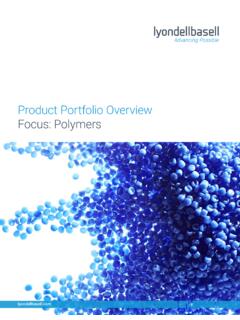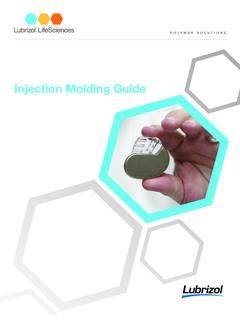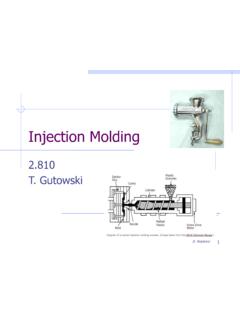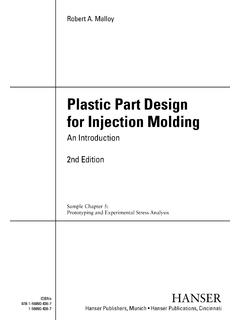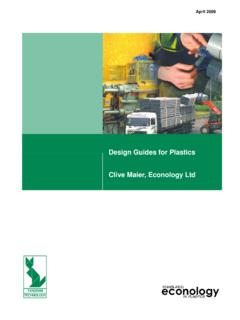Transcription of Introduction to Extrusion - Dynisco
1 38 Forge Parkway | Franklin, MA 02038 USA | Tel: +1 (508) 541-9400 | Fax: +1 (508) - Introduction to Extrusion1. Single Screw Extrusion2. Twin Screw Extrusion3. Extrusion Processes4. Safety24814138 Forge Parkway | Franklin, MA 02038 USA | Tel: +1 (508) 541-9400 | Fax: +1 (508) -SINGLE SCREW EXTRUSIONE xtrusion may be defined as a process for making a product (an extrudate) by forcing a material through an orifice or die to form a shape, or alternatively, the production of finished, or semi-finished products, using an of the HandbookThis book will be mainly concerned with the Extrusion of thermoplastic products because of their im-portance in Extrusion processes. Thermoplastics are by far the largest group of plastic materials extrud-ed; approximately 65% of all plastics pass through an extruder. As the most popular type of extruder is the single screw machine, this book will mainly concentrate on processes based on that type of ma-chine. Single screw machines are the most popular because they are relatively simple, cheap and easily give a continuous and ThermoplasticsIn Extrusion of a thermoplastic, heating first softens the material so that it can be shaped.
2 The Extrusion machine, or extruder does this process. This heat softening is called by various names, such as plasti-cation , plasticization or thermal softening . Most extruders are single screw machines. It is the screw which forces the material towards, and then through, the die. Shape is imparted by the die, and/or by post- Extrusion forming, and then the product is set to shape by cooling it while maintaining its shape. The equipment that does this is called the post Extrusion equipment, while the whole system is called an Extrusion ClassificationExtruders may be classified by three figures, for example, 1-60-24. The first number states how many screws the machine has, the second number specifies the screw diameter in millimeters (mm) and, the third number specifies the effective screw length as a multiple of the screw diameter. In the example given therefore, a single screw machine is being described that has a screw of diameter 60 mm and a length of 24 screw diameters (that is, a L/D ratio of 24/1).
3 Machine ConstructionA cut-away drawing of a simple single screw machine is shown in Figure 1. This shows the arrangement of the different parts of the machine. The screw and barrel are the two units that interact to convey the plastic material, melt the material and then force it through the die. The electric motor drive unit andgearbox rotate the screw at a predetermined speed. Temperature controllers are connected to heating/cooling elements on the barrel to hold the temperature at the set-point temperatures. The ability of the screw and barrel assembly to extrude a given material is dependent on the characteristics of the plasticsmaterial, the characteristics, or construction, of the screw and barrel, and the conditions under which the system is Forge Parkway | Franklin, MA 02038 USA | Tel: +1 (508) 541-9400 | Fax: +1 (508) -Post Extrusion EquipmentOnce the extrudate leaves the die it can either be set to the shape to be produced or have its shape altered and then set to shape.
4 The equipment that does this is called the post Extrusion equipment or the haul off and in terms of size it is usually far larger than the extruder. One reason is that plastics take a long time to cool. This cooling process often determines how fast the line will of ExtrusionThe products of Extrusion include: Feedstock for Other plastics Processes: Extruders are widely used as compounders, or mixers. The output from an extruder compounder is granulated or chopped to form the feed for another process, such as, injection molding or Extrusion Plastic Film: This is usually used for packaging or sealed into bags Plastic Pipe: Used for gas, water, drains, etc. Plastic Tubing: Used for hose and tubing for automobiles, laboratories, etc. Plastic Insulated Wire and Cable: Used in the home and industryfor appliances, for electric power distribution, communications etc. Profile: Used for tracks, windows, doors, home siding, gaskets, etc. Filaments: Used for brushes, ropes, twine, etc.
5 Sheet: Used for signs, lighting, glazing, etc. Nets: Used for packaging, soil stabilization, etc. Plastic Coated Paper and Metal: Used for packaging 338 Forge Parkway | Franklin, MA 02038 USA | Tel: +1 (508) 541-9400 | Fax: +1 (508) -Co-ExtrusionCo- Extrusion is a process where two, or more, melt streams are combined in a die to produce an extrudate formed from two, or more, materials. The process is now associated with thermoplastics materials although it was first practiced with rubbery polymers to produce an extrudate with different colored layers. With thermoplastics, the layers of materials are commonly combined in the die. The simplest example combines just two layers, for example a colored layer on a natural core, which saves on colorant costs. In the packaging industry, films based on three or more layers are now common. Laminating two or more layers of different polymers together can produce a product that has barrier properties far superior to those obtained when only one polymer is used.
6 Frequently, one of the polymers used is a gas or moisture barrier layer based on polyvinyl alcohol (PVAL). To produce three layered structures, two or three extruders are usually used. In the blow- molding process it is possible to combine co- Extrusion with bi-axial orientation to produce strong, lightweight bottles which give a long storage life to the products. Layered co- Extrusion is not the only type of co- Extrusion . By arranging for the materials to be combined one after the other, a sequential co-extrudate may be produced. This may consist of a hard thermoplastic material joined to a soft thermoplastic material. Alternatively, two materials may be extruded side-by-side, such as a clear material alongside an opaque material, to produce sheet to make thermoformed ExtrusionA vented extruder is an extruder that contains a vent, which is used to extract volatiles from a plastic material during the Extrusion process. The water (moisture) and volatiles content in a plastic material may be reduced to acceptable levels by the use of a vented machine.
7 Part of the way along the Extrusion barrel the melt is decompressed by reducing the screw root diameter. A vent, through which the vapor escapes, is located at this point in the barrel (the vent may be plugged and not used when venting is not required). The vapor-free melt is then conveyed towards the die and re-compressed by increasing the screw root diameter. To ensure that melt does not escape through the vent, a dam or torpedo section is incorporated on the screw just before the vent. Because of the way that vented machines are constructed (a high L/D ratio and a variable screw geometry) and operated, it has been found that they produce very good mixing. It should be remembered, however, that pre-drying of the polymer may be more appropriate, since heating some plastics in contact with water may cause their decomposition, or SCREW EXTRUSIONTwin screw Extrusion machines or, twin screw extruders, are the simplest example of multi-screw machines (Figure 2.). The two screws may rotate in the same direction (co-rotation) or they may rotate in opposite directions (counter or, contra-rotation).
8 The flights of the screws may intermesh or they may not intermesh. As intermeshing, or partially intermeshing, types of machines are the most popular the discussion which follows is restricted to this type of Forge Parkway | Franklin, MA 02038 USA | Tel: +1 (508) 541-9400 | Fax: +1 (508) -Uses of Twin-Screw ExtrudersTwin-screw machines have always been popular for certain processes, for example, where there is a need for a compounding step as well as an Extrusion step. This is particularly true for un-plasticized polyvinyl chloride (UPVC). This material is often stabilized against heat degradation by the use of heavy metal compounds (like organic tins, or lead) and such stabilizers are expensive. Thus, for economic reasons, the amount of these heat stabilizers must be kept as low as possible. One way of doing this is to compound and extrude in one step. This saves a further heating stage (if the material is first compounded, cooled and then re-extruded). Twin screw machines are widely used to make UPVC pipe and profiles.
9 Today they are often used to compound other plastics , or resins, with additives to make compounds for use in other Extrusion or injection molding and CharacteristicsWith a single screw extruder the hopper is filled and the screw takes in the material at the rate it wants. Such a scheme, called flood feeding, is often not possible with twin screw machines. This is because the very positive feeding characteristics of twin screw machines may result in very high forces being generated. These forces may be so high that thrust-bearing failure is a real danger. Twin-screw extruders are therefore often starve fed, resulting in a through-put independent of screw speed. The average residence time is inversely proportional to the screw speed and feed rate and, therefore, decreases with increasing output. The Specific Energy Consumption, or the energy input per unit mass of material, also decreases with increasing throughput. The output is often virtually independent of the size of die used.
10 Because of the mixing action, twin screw ma-chines can achieve more melting, mixing and conveying in a shorter machine length than a single screw machine. They are, however, much more Forge Parkway | Franklin, MA 02038 USA | Tel: +1 (508) 541-9400 | Fax: +1 (508) -Co-Rotating or Counter-Rotating MachinesBoth types of twin screw extruders have distinct advantages that lead to their use in specific applications. Counter-rotating machines are used for the Extrusion of UPVC and co-rotating machines are used for compounding applications. The counter-rotating machine has very positive material feed and conveying characteristics. The residence time and material temperature control in the machine are also uniform. However, air entrapment, generation of high pressure, low maximum screw speed and output are disadvantages usually encountered. The advantages of the co-rotating machine are that the screws wipe each other clean (self-wiping), high screw speeds and high outputs are possible, particularly for materials which are not very shear, or heat, sensitive (such as PE).
